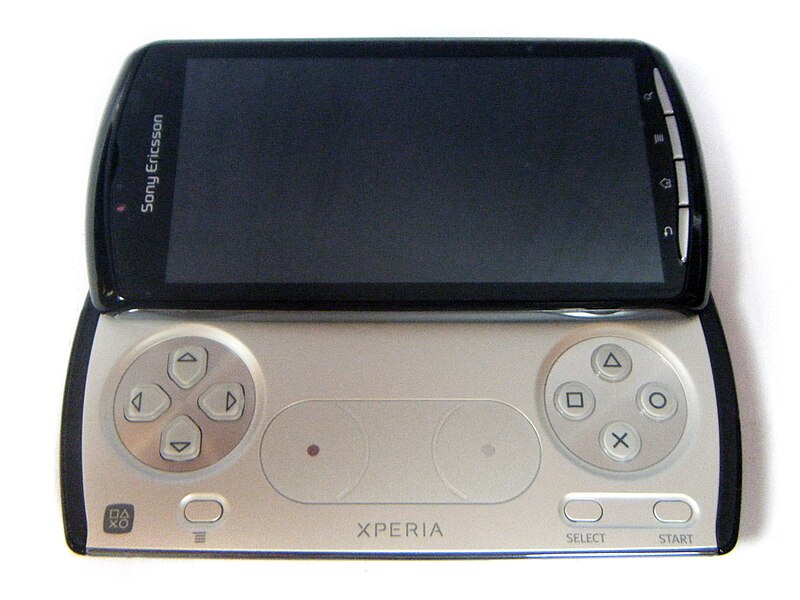History of video games/Platforms/Xperia Play
-
The Sony Ericsson Xperia Play gaming smartphone.
Introduction
editWith the rise of the Smartphone came the rise of Smartphone gaming, a phenomenon that was recognized as posing a serious risk to handheld gaming consoles.[1] The Xperia Play was a mobile phone game console hybrid concept that sought to bridge the two, leveraging the strengths of dedicated gaming hardware with the flexibility of a smartphone. While the Xperia Play was far from the first device to try this concept, it was the first Android Smartphone to try this concept,[2] as well as the first gaming smartphone to use a major console brand in its promotion.
History
editLaunch
editIn 2011 the Sony Xperia Play launched as a gaming oriented Android 2.3 3G smartphone that was gaming oriented and could play classic PlayStation games.[3] The critical reception of system was mixed, with reviews either tending to be lukewarm notes of a device held back by its shortcomings,[4] or containing beaming praise for the potential of the device.[5][6] The device was available in black as well as "Stealth Blue".[7]
Legacy
editLittle is known about the market performance of the Xperia Play. However a followup device was never released.[2]
In late 2020 images of a potential Xperia Play 2 were leaked online, but could not be verified.[8][9]
Technology
editThe Xperia Play uses a 32 bit single core ARM Qualcomm MSM8255 Snapdragon clocked at 1 gigahertz, with a Adreno 205 clocked at 266 megahertz, and a Hexagon DSP clocked at 256 megahertz.[10][11]
The Xperia Play has 512 MB of LPDDR2 RAM.[10][11] While this matches the amount of RAM used by Sony's PlayStation Vita,[12] this was fairly standard in what Android phones typically offered in 2011, with several higher end phones offering a bit more RAM or even double this amount.[13]
Xperia Play optimized games
editGallery
editConsole Hardware
edit-
The Xperia Play opened.
-
The Xperia Play closed.
Promotion of the Xperia Play
edit-
People use the Xperia Play at Mobile World Congress 2011
-
The Xperia Play being promoted at the 2011 Tokyo Game Show
Photos taken with the Xperia Play
edit-
Central London on a bright day, taken with an Xperia Play
-
The Arga Fort, taken with the Xperia Play on an overcast day.
-
A low light photo of a lantern taken with the Xperia Play.
External Resources
editReferences
edit- ↑ "The road ahead in mobile games". VentureBeat. 10 July 2011. https://venturebeat.com/2011/07/10/the-road-ahead-in-mobile-games/.
- ↑ a b "A brief (and depressing) history of gaming phones" (in en). Engadget. https://www.engadget.com/2018-06-09-a-brief-and-depressing-history-of-gaming-phones.html.
- ↑ a b "Review: Sony Ericsson Xperia Play". Wired. Retrieved 30 October 2020.
- ↑ "Sony Ericsson Xperia Play Review - IGN" (in en). https://www.ign.com/articles/2011/05/28/sony-ericsson-xperia-play-review.
- ↑ Hanlon, Joseph. "Sony Ericsson Xperia Play" (in en). CNET. https://www.cnet.com/reviews/sony-ericsson-xperia-play-review/.
- ↑ Chester, Edward. "Sony Ericsson Xperia Play Review" (in en). Trusted Reviews. https://www.trustedreviews.com/reviews/sony-ericsson-xperia-play.
- ↑ "AT&T launches Sony Ericsson Xperia Play with Gingerbread, blue color option" (in en). Engadget. https://www.engadget.com/2011-07-12-atandt-launches-sony-ericsson-xperia-play-with-blue-color-option.html.
- ↑ Vincent, James (23 September 2020). "The sequel to Sony's PlayStation Phone apparently leaks, eight years too late". The Verge. Retrieved 30 October 2020.
- ↑ Minkov, Radoslav. "This PlayStation Phone was ahead of its time – Odd Phone Mondays". Phone Arena. https://www.phonearena.com/news/playstation-phone-xperia-play-was-ahead-odd-phone-mondays_id133527.
- ↑ a b "Sony Ericsson Xperia Play review". Engadget. Retrieved 30 October 2020.
- ↑ a b "List of Qualcomm Snapdragon processors". Wikipedia. 22 October 2020. Retrieved 30 October 2020.
- ↑ Yin-Poole, Wesley (18 August 2011). "Sony: why PS Vita has 512MB of RAM" (in en). Eurogamer. https://www.eurogamer.net/articles/2011-08-18-sony-why-ps-vita-has-512mb-of-ram.
- ↑ PM, Elias Samuel 01/11/11 AT 2:18 (11 January 2011). "Is Motorola Atrix 4G first smartphone to feature 1GB RAM and longest battery life?". International Business Times. https://www.ibtimes.com/motorola-atrix-4g-first-smartphone-feature-1gb-ram-longest-battery-life-253455.
- ↑ a b c Hanlon, Joseph. "Complete list of Xperia Play optimised games". CNET. Retrieved 30 October 2020.
